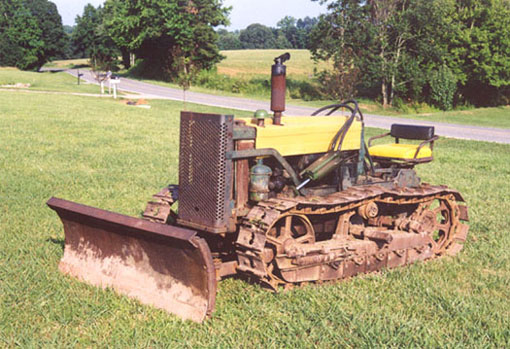
| The Dubuque Crawlers | |
| MC, 40C, 420C, 430C, 440IC and 440ICD |  |
Home My JD 40s Tractor Shows Links Contact Us
Crawlers are my favorite type of equipment and the models produced at the Dubuque Works are the ones I really get excited about. Almost all of John Deere's Crawlers up to the present were made at the Dubuque plant. John Deere's crawler production began with an agreement with Lindeman in Yakima, WA. Lindeman took some JD model GPs and fitted them with tracks back in 1942. From those experiments, the Lindeman BO crawler was born.
The MC was introduced in 1949. It used the Lindeman designed undercarriage. The 40C was a much improved crawler from the MC and was introduced in 1953 but used an undercarriage from the MC. The 40 undercarriage changed in 1954 to a new design and these crawler became the first crawlers totally produced at the Dubuque works.
The popularity of the 420C is evident in the production numbers with more units produced than any other model. Introduced in 1956, the 420C changed in mid-production as the 40C did, getting bigger drive components in the second year and a new design engine in the last year of production along with more drive train improvements.
The 430C is the rarest of the Dubuque crawlers. Only 2240 were sold. Sales of the 440IC and 440ICD likely cut into the 430C sales. It was esscenally a 420C with new sheet metal. The 440s were the beginning of a true industrial line for John Deere and were the first crawler available with an optional diesel engine. The 440IC is also notable as it was the last gas engine tractor produced at the Dubuque Works.
The number of crawler models produced at the Dubuque Works were:
MC 10,509
40
11,689
420 17,882
430 2,240
440 16,534
The Differences in the Models
Some of the crawlers look very much alike and with modifications made by their owners, it can be very hard to tell what model it really is. You can't go by the mounted equipment (bulldozer blades or loaders), as a single model of equipment was put on multiple models of crawler.
You can't go by paint. John Deere painted some of every model of crawler yellow, if it was requested by the customer or if marketed as an industrial unit. The yellow stripe on the hood was added to the 420 in the second year of production. However, units get repainted according to the owners tastes. A yellow stripe could be added to a 40 or a 430 could be all green if the owner didn't want to mask and paint the yellow stripe.
Sometimes you can't go by the sheet metal. I've seen a 40 grill on an MC. Add to this, the possibility that the engine was swapped and it can be very difficult to tell what a machine really is.
These are some of things to look for in case your crawler has no serial number plate.
| The MC was a 3-roller crawler. It should have the serial number on a plate under the ignition switch. The throttle lever sticks out from the dash 6 or 7 inches. The engine has no water pump, being a thermo-siphon system. The track pad, if original, had very rounded edges. They had a four speed transmission with a straight shift lever. The drawbar was cast. | 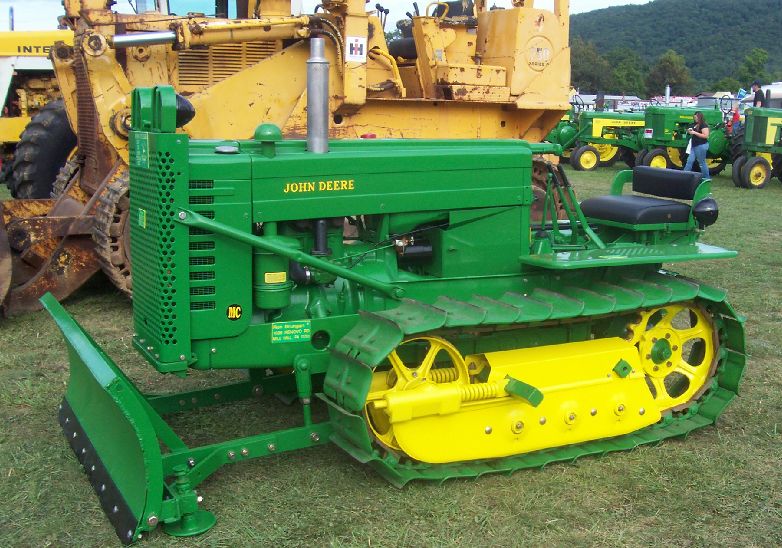 |
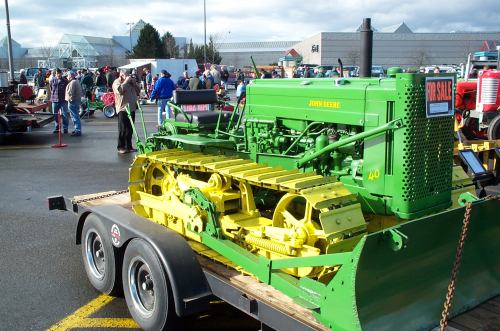 |
The 40 has the same engine as the MC. The serial number plate was on the left hand side of the torque tube, the part between the engine and transmission. The 40 dash was a cast frame with a sheet metal insert holding the gauges and ignition switch. The transmission was still a four speed but has a shift lever that's bent forward. Early 40s had a 3 roller undercarriage. Later ones could have a 4 or a 5 roller. The drawbar was made of several steel flat stock pieces. |
| The 420 had a new engine, of sorts. The bore was increased from 4 to 4 1/4 to increase horsepower but the block was a 40 block. Because of the bore increase, the thermo-siphon cooling system was not adequate to keep the engine at proper temperature so a water pump was added. The block was modified to be able to mount the water pump. On the first year 420s, aside from the engine, the rest of the crawler was the same as the 40. They had four speed transmission and painted all green out of the factory. | 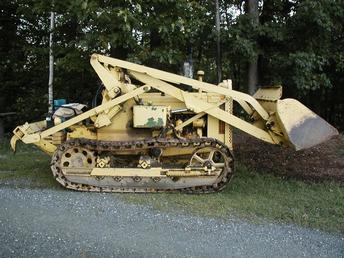 |
| The second year 420s had a new engine block, and a optional 5 speed transmission. The yellow stripe on the hood was added this year as well. For the third year, the dipstick was moved to the right side of the engine and was a large cap with the dipstick attached to the underside. You could order a 4 or 5 roller undercarriage and get a yellow industrial paint job as a no cost option. |
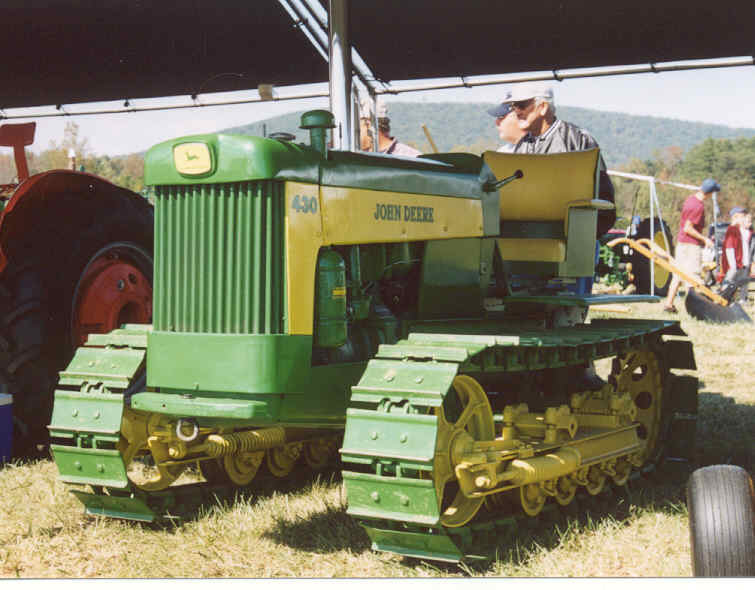 |
The 430 had the same engine as the late 420s and 440s but all new styling. It had a design change in the metal in that the grill has a flat spot on the middle top where a jumping deer medallion was mounted. The top oil fill tube was removed and the hole eliminated from the hood. The dash was slanted up toward the operator for a better view of the gauges. Optional was a deluxe armchair seat and your choice of 4 or 5 roller undercarriage. |
| The 440 was the first true industrial crawler. It had a heavy cast grill and hood made of thick steel to protect the tractor and resist dents. Heavier finals and axles than the 420/430 model made it a truly rugged machine. It could be ordered with a GM 2-53 two cylinder diesel engine, a first for John Deere. It was only available in a 5 roller configuration. They were identified as a 440IC (IC meant Industrial Crawler with a gas engine) and 440ICD (Diesel engine). | 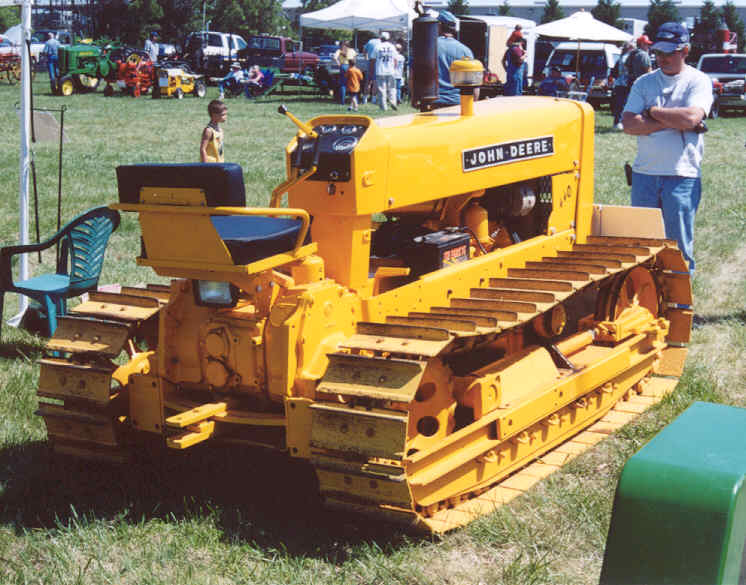 |
To identify a JD crawler engine, start with the water pump. MC and 40C didn't have one. If it has a water pump and a larger oil dipstick on the right side, it's a phase 3 model 420C or 430C. One with a water pump but, without the the large dipstick on the right, is a phase 1 or 2 420C.
Optional equipment
Bulldozer blades and loaders were available from Deere and Company or from outside manufacturers. Some outside vendors had marketing agreements with Deere. You could order their equipment at your local Deere dealer just like piece of John Deere equipment. Side booms for pipe laying, and backhoes could be mounted on some of the crawler models. These crawlers towed equipment like land levelers, plows, graders and logging arches also.
If you have a picture of your crawler you would like to share, email it to us. Send your name and any information about the crawler you might have. I'll post it here.
Designed and built by DL